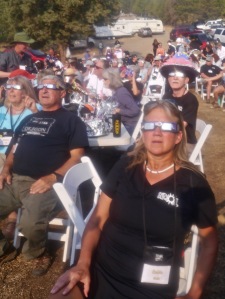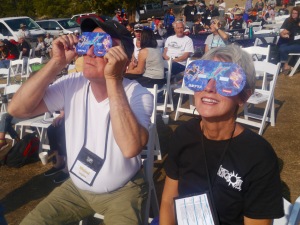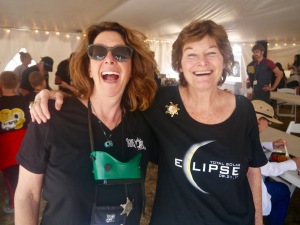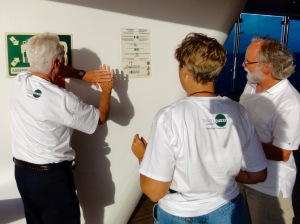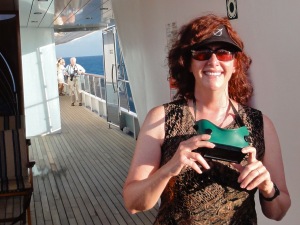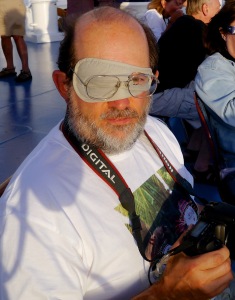Follow this link to hear my very excited and hopeful (and in retrospect, sad) RNZ interview with First Up host Lydia Batham, recorded at sea on the M/S Paul Gauguin after leaving Pitcairn Island.
Tag Archives: corona
Blackout Rally recap
 300-plus Airstream trailer enthusiasts—many members of the Oregon Airstream Club, Greater Los Angeles and NorCal units of the Wally Byam Airstream Club—camped together at Lake Simtustus in Madras, Oregon to await the Great American Eclipse. To kill time before totality, a 3-day party was planned that included an eclipse presentation and evening telescope starparties with astronomer Brian Bellis from California, a drawing class, a geology lecture, catered meals each day, Cachaça spirit tasting at happy hour, live entertainment (Antsy McClain from Nashville!), and a “Day on the Dock” party hosted by Airstream Adventures Northwest (Airstream Inc.’s #1 dealer).
300-plus Airstream trailer enthusiasts—many members of the Oregon Airstream Club, Greater Los Angeles and NorCal units of the Wally Byam Airstream Club—camped together at Lake Simtustus in Madras, Oregon to await the Great American Eclipse. To kill time before totality, a 3-day party was planned that included an eclipse presentation and evening telescope starparties with astronomer Brian Bellis from California, a drawing class, a geology lecture, catered meals each day, Cachaça spirit tasting at happy hour, live entertainment (Antsy McClain from Nashville!), and a “Day on the Dock” party hosted by Airstream Adventures Northwest (Airstream Inc.’s #1 dealer).
Day on the Dock included a fishing derby, water toy relay race (involving a hydrobike, kayaks, and an SUP), incredible prizes, a big ol’ freezer of free ice cream, and a “Hot dogs for Hot Shots” fundraiser for local firefighters who have been working overtime this season to prepare for the eclipse in Central Oregon. (The Oregon Airstream Club raised well over $2000!)
On Monday August 21 all eyes were on the sky as we gathered together to await totality, wearing our custom eclipse glasses. Several rocked tin-foil hats.
At dawn on eclipse day I glared at the thin haze in the sky, and the brownish accumulation wafting from a wildfire on Warm Springs reservation toward our viewing location. “I’m not a fan,” said astronomer Bellis, and the eclipse chasers and telescope buffs agreed that the advertised crystal blue sky of Central Oregon was not to be that day—but visibility was improving with each passing hour and everyone remained hopeful and excited.
Several telescopes were positioned to study the significant sun spot activity and the big prominences. Bellis brought a terrific “funnel projector” and an attendee made a nice pinhole headbox. Lots of folks brought colanders from their Airstream galleys to observe rows of neat and orderly crescent projections. After planning this event for seven years, it was finally going down.
The phenomena occurred on cue as 10:19 a.m. approached: sharpened shadows, eerie changes in the light, and even shadowbands—my first viewing ever, collected on a big piece of white foam core.
What a thrill and blessing to hear the gasps and cheers of 350 people when totally slid into place after a dazzling diamond ring. (Post-eclipse regret: why didn’t I make an audio recording? Hopefully someone else did.)
Something amazing WAS captured on video and in a still shot by one of the guests: during totality, a skydiver sailed right across the eclipsed sun. I hope that guy makes some good money selling the image to Astronomy magazine.
The coronal streamers were only slightly diminished by the haze, and at third contact the crowd cheered again and many brushed away a tear or two. I held it together until someone crying ran up to give me a hug. Sharing the beauty of our planet with other Earthlings and feeling our place in the solar system and the universe together always touches me deeply, and I try to carry that feeling forward until it refreshes during the next eclipse. (2019, ya’ll.)
After totality we enjoyed a catered brunch and a champagne toast delivered by special guest Thomas D. Jones, NASA astronaut/spacewalker. He delivered a fascinating presentation about the ongoing role of NASA missions, answered questions about what it’s like to live and work in space, and stuck around to autograph books and inspire kids.
Until next time, clear skies!
Above: The Oregon Airstreamers
Below: Pin the moon on the sun; eclipse style statement; eclipse cookies; ‘scope action; awaiting totality; third contact smiles; NASA astronaut Tom Jones; I’m seven for seven! (Hubs is two for two.)
The total eclipse postage stamp!
 In June the US Postal Service will release a commemorative stamp to celebrate TSE2017, and it will be a big, big first: a stamp that changes when you touch it.
In June the US Postal Service will release a commemorative stamp to celebrate TSE2017, and it will be a big, big first: a stamp that changes when you touch it.
The heat of your finger will react with the stamp’s thermochromic ink to reveal an image of the full moon over a solar corona. It will revert back to a totally-eclipsed sun when it cools.
The “Total Solar Eclipse Forever” stamp will be made available on June 20, 2017 after its First-Day-of-Issue ceremony at the University of Wyoming in Laramie. (Am I the only Oregonian disappointed that it’s not taking place in Madras?) Apparently there’s some kind of druid sculpture there that manifests its magical properties on that day, the summer solstice.
The image on the new stamp was selected from among Fred “Mr. Eclipse” Espenak’s fine collection of totality photographs, that was shot during the eclipse over Egypt/Libya in 2006.
On the back (each pane of 20) will be the path of totality on August 21, featuring the largest cities and towns in the shadow.
Learn more (and watch for preorder information) at the USPS website.
(Fellow philatelic umbraphiles, spread the word! Uncle Sam says use hashtag #EclipseStamps.)
Great Barrier Reef
 Oh, the eclipse? *yawn* Just another breathtaking miracle of nature.
Oh, the eclipse? *yawn* Just another breathtaking miracle of nature.
The sky was blue and the Orion steady on eclipse day, following two grueling days on choppy seas to return to the calm waters over the Great Barrier Reef near Port Douglas.
Jay Anderson—meteorologist, astrophotographer, and co-author of the NASA eclipse bulletins with Fred Espenak—commanded a microphone and walked us through the timeline of events. Meet Jay in this video and hear his play by play (“filters off!” “shadow bands behind you!”). Jay also consulted with the captain and special reef pilot who was brought on board to guide the Orion over the Reef and ensure the best viewing area.
Thanks to his coaching I got my goggles on and off in time to witness all the phenomena. Baily’s beads were meh but we saw the best. diamond. ring. EVER. The prominence flames were higher than I’ve ever seen them too.
At third contact many beers (Corona, natch) were consumed, followed by brunch on deck and a how-was-it-for-you debriefing session in the Leda Lounge for the relieved and excited chasers. Most of them were either first time virgins—virgins no longer!—or had just racked up their 10th or 15th TSE. Me?
Six for six, and counting.
The moments on deck are captured in this 5-minute video. If you’re hoping to see the eclipsed sun itself, lower your expectations: this captures the minutes leading up to totality on deck, and before and after reactions. (Here’s a 3-minute video of totality—again, no sun, but you’ll see the sky go dark and brighten at third contact.
Above: Diamond ring photo via Snapfish, taken from the Paul Gauguin, July 10, 2010
Below:
Scenes on board the Orion, November 13, 2012.
Variety of customized gadgetry, including scope “squint” aids and fancy pinhole projection art.
TravelQuest founder and president Aram Kaprielian. (Is there a bigger smile than the one on the tour director after a cloudless TSE?)
Eclipse at 16,000 feet
 To be accurate, 15,702 feet; a private train took us to view totality on the Altiplano along the Rio Mulatos-Potosi railway line, the world’s ninth highest.
To be accurate, 15,702 feet; a private train took us to view totality on the Altiplano along the Rio Mulatos-Potosi railway line, the world’s ninth highest.
The train was beyond rustic. Eight hours of squeaking metal, with hard seats in cold and cramped compartments. To get to the dining car (for yet another meal of pollo and fries) we had to take a giant step between the cars, the rushing tracks visible in the yawning, swaying crack below.
We boarded the evening before the eclipse and the train clattered through towns and remote villages for hours, higher and higher into the night. We handed our freebie paper eclipse shades and filters out to villagers when the train stopped. We moved through a huge All Souls Day celebration with covered tents and couples dancing, bands playing caporal and cumbia music, people holding up their beers to toast us as we pass.
All the trains to the centerline were coordinated from below and embarked from the station two miles apart, and the nighttime passage and early arrival time ensured that no smoke, light or vibration would pollute the eclipse viewing areas.
The train screeched to a stop at 4 a.m. where the weather satellite said to, somewhere outside Sevaroyo. With the trains filled with groggy travelers suddenly silently in place, it was hushed and dark and cold before dawn on eclipse morning.
No flashlights or flash photography were allowed. We were advised to dress in warm layers—there would be no heat, no generator—and prepare to be on camera: an accompanying film crew hired by National Geographic was about to go to work.
After a hurried breakfast we all piled out onto the dark desert with our scopes and cameras; we were late arriving, and there wasn’t much time for observing before sunrise at 6:30. I saw Crux, the Southern Cross for the first time—a stargazer’s milestone and proof that a North American traveler is very far from home.
I was excited to be observing at a high-altitude site—about as far from my sea level first eclipse as possible—where the coronal streamers were expected to be long and bright (as light from the corona wouldn’t be dulled by Earth’s atmosphere). The air was thin and the wind was chilly. Local children, families, and military guards armed with machine guns materialized to view partiality through our solar scopes and eclipse glasses. I later learned that only 600 souls were present on the Altiplano.
The short three-minute totality began at 8:22 a.m. at 35.80 degrees above horizon. As predicted, the delicate corona was detailed and luminous. I got a good look at Baily’s Beads (for those who don’t know, these are the dots of light in a ring formed by SUNLIGHT SHINING THROUGH THE MOUNTAINS ON THE MOON, sorry, I can hardly fathom it), and this time, both diamond rings.
Above: Sunrise on the Altiplano
Below:
Boarding the ENFE train
Viewing site
Locals and travelers witness together
Group shot at the train
A word about photography.
 My photographer boyfriend, like all amateurs, tried and failed to capture the image and feeling of totality, though he got some good cookie bites (cast orange by the solar filter). The eclipse is just too far away, too contrasty, and too complex. Unless you’re a pro, it will never fill your camera the way it fills your eyes, heart, and memory.
My photographer boyfriend, like all amateurs, tried and failed to capture the image and feeling of totality, though he got some good cookie bites (cast orange by the solar filter). The eclipse is just too far away, too contrasty, and too complex. Unless you’re a pro, it will never fill your camera the way it fills your eyes, heart, and memory.
Some advice for others who will try nonetheless: the only effective way (I’m told) is to expose for the corona, overlay a shot of the black disc of the moon, and create a final image of the two. Right, astrophotographers? Please comment and tell me how you do it, if you care to share.
Fred Espenak, aka “Mr. Eclipse”, offered his photo tips through a recent webinar; a recording may still be available online.
You do have access to “the finest collection of images of a total solar eclipse ever assembled”: order a backcopy of the November 1991 issue of Astronomy’s Great Eclipse Photo Contest.
Mexico epilogue: The boyfriend? He was a character but is now a thing of the past. I moved on to experience five more eclipses with a short parade of subsequent husbands, and ventured out on my own as well. It took three years to save for the next adventure: an unforgettable odyssey in Bolivia.
Above: Non-pro photo of the diamond ring
Below:
Cookie bites (with visible sunspots)
Pro shots: Local photographer Carrizosa (check it out, he got Buzz Aldrin’s autograph); Totality via Fred Espenak; Diamond ring via Snapfish.
Totality and beyond
 Afraid to damage my eyes, I wore my welder’s glasses too long and missed the beginning of the diamond ring, but whipped them off in time to see totality pop into place. The solar corona quickly brightened to reveal a shocking black hole, delicate white streamers, and red flames of the sun. A splendor, a marvel, a miracle. It seemed to make a sound in my head, and fill the sky. Tears stung my eyes.
Afraid to damage my eyes, I wore my welder’s glasses too long and missed the beginning of the diamond ring, but whipped them off in time to see totality pop into place. The solar corona quickly brightened to reveal a shocking black hole, delicate white streamers, and red flames of the sun. A splendor, a marvel, a miracle. It seemed to make a sound in my head, and fill the sky. Tears stung my eyes.
My guy and I grabbed a quick smooch for luck (like you do), and he shot a few frenzied photos, but mostly we gawped, wordless. A few people near us whooped and cheered; others stood in stunned silence, grinning. Six minutes and 53 seconds passed in an instant, and at third contact we lunged for the calendar of upcoming eclipses to start planning the next one.
As with all drugs, the first time is the best time and leaves you craving more.
Afterwards we joined a street party where I drank something dark yellow—probably mescal—from a plastic jug being passed among the crowd. Did not die.
My first eclipse experience—from the time we landed in Cabo to the end of fourth contact —was nothing short of magical. Reports of totality included phrases like “for sheer beauty, it ranks among the best”; the large, detailed corona “had a three-dimensional appearance”; a “pink chromosphere wrapped all around the south”; a naked-eye “crimson pair of huge, glowing prominences” extended to the east and west; and “it seemed like someone tied a ghostly bow around the sun.”
A writer in Sky said, after third contact, “The light returned. The wind off the sea returned…everything was as it was before, only everything had changed. Maybe I had changed.”
The Great One as seen from Baja did not disappoint—and it launched a very expensive hobby.
Above: Totality (not my photo)
Below:
Celestial bodies visible during totality on July 11, 1991
Trying to photograph the eclipse. (Tip: don’t bother.)
Thumb’s up at third contact
A toast
Plotting number two








